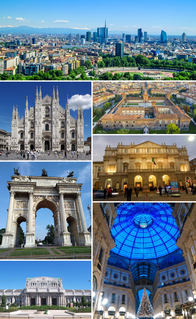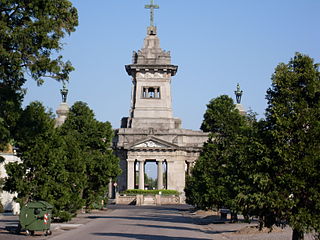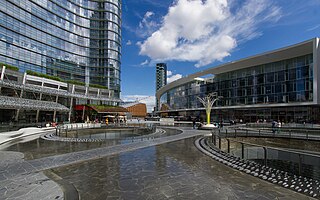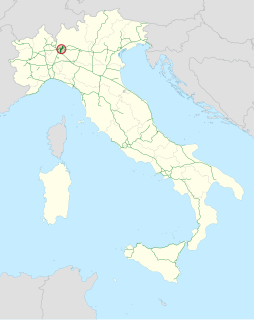
Milan is a city in northern Italy, capital of Lombardy, and the second-most populous city proper in Italy after Rome. The city proper has a population of about 1.4 million, while its metropolitan city has 3.26 million inhabitants. Its continuously built-up urban area is the fourth largest in the EU with 5.27 million inhabitants. According to national sources, the population within the wider Milan metropolitan area, is estimated between 8.2 million and 12.5 million making it by far the largest metropolitan area in Italy and one of the largest in the EU.

Cannon Falls is a city in Goodhue County, Minnesota, United States. The population was 4,083 at the 2010 census. Located along U.S. Route 52, southeast of the Twin Cities, Cannon Falls is the home of Pachyderm Studio, where many famous musicians have recorded, including Nirvana, which recorded its 1993 album In Utero there.

The Province of Milan was a province in the Lombardy region, Italy. Its capital was the city of Milan. The area of the former province is highly urbanized, with more than 2,000 inhabitants/km2, the third highest population density among Italian provinces, just below the densities of the provinces of Naples and of Monza e Brianza, the latter of which was created in 2004 from the north-eastern part of the province of Milan. On 1 January 2015 the province was replaced by the Metropolitan City of Milan.

Greco is a district ("quartiere") of Milan, Italy, part of the Zone 2 administrative division, located north-east of the city centre. Before being annexed to the city of Milan it was an independent comune, named Greco Milanese. As "Greco" is the Italian word for Greek, it has been suggested that the name refer to an old Greek settlement in the area; nevertheless, scholars tend to believe that the place was actually named after the Greco family that used to live here.

Città Studi is a district ("quartiere") of Milan, Italy, located within the Zone 3 administrative division. Its name comes from the fact that the Politecnico technical university, as well as most technical and scientific branches of the University of Milan, are based in this area. The area also houses several prominent hospitals of Milan, including the IRCCS National Cancer Foundation and the Carlo Besta Neurological Institute.
Taliedo is a peripheral district ("quartiere") of the city Milan, Italy, part of the Zone 4 administrative division, located south-east of the city centre. The informal boundaries of the district are three main city streets, respectively Via Mecenate, Via Bonfadini and Via Salomone.
Morivione is a district ("quartiere") of the city of Milan, Italy, part of the Zone 5 administrative division, located south of the city centre. It is informally defined as the area enclosed within four streets, namely Viale Toscana, Via Ripamonti, Via Antonini and Via Bazzi. The district is especially associated to the celebrations in honour of Saint George, where Milanese people would traditionally drink milk and eat a kind of sweet called pan de mein.
Vaiano Valle is a rural district ("quartiere") of Milan, Italy, part of the Zone 5 administrative division. It is located south of the city's urban area, within the Parco Agricolo Sud Milano nature reserve. Before 1869, it was an autonomous comune.

Barona is a border district ("quartiere") of the city of Milan, Italy. It is part of the Zone 6 administrative division, and it is located south of the city centre. Its population can be roughly estimated to 85,000. It borders on the comunes of Buccinasco, Assago, and Corsico and the districts of Lorenteggio and Torretta. Its boundaries are marked by the Parco Agricolo Sud Milano nature reserve to the south, by the Naviglio Grande and Naviglio Pavese canals to the east and to the west, and by the Circonvallazione ring road to the north.
Ghisolfa is a district ("quartiere") of Milan, Italy, part of the Zone 8 administrative division of the city, located north-west of the city centre. It is named after the "Ghisolfa Bridge" overpass, part of the external Circonvallazione ring road enclosing the centre of Milan. In turn, the bridge was named after two cascine, "Cascina Ghisolfa" and "Cascina Ghisolfetta", that existed in the area before the urbanization of the mid 20th century. The bridge was completed in 1941, prolonged in the 1960s, and enlarged in the 1990s.

Quarto Oggiaro is a district of Milan in the north-west of the city. It belongs to Zone 8, and has a population of 35000 inhabitants.

QT8 is a district ("quartiere") of Milan, Italy, part of the Zone 8 administrative division of the city. The name formally stands for Quartiere Triennale 8, but the district is also simply referred to as QT8.

Gallaratese is a district ("quartiere") of Milan, Italy, part of the Zone 8 administrative division of the city. It is located about 7 km north-west of the city centre. It borders on the comune of Pero to the north and on the districts of Trenno to the west and Lampugnano to the south; to the east, its ideal border is the eponymous street, which in turn is named after Gallarate, the town it leads to.

Bovisa is a district (quartiere) of Milan, Italy, located north of the city center, in the Zone 9. The name is supposedly derived from the Italian word bove, meaning ox, as the area developed from an ancient rural settlement.

The Zone 2 of Milan is one of the 9 administrative zones of Milan, Italy. In the "sunburst" geometry of the zones of Milan, Zone 2 is the slice that connects the centre to the periphery in the north-east direction.

The Cimitero Maggiore di Milano, also known as Cimitero di Musocco, is the largest cemetery of Milan, Italy. It is located in Zone 8, in the Musocco district, not far from the Garegnano Charterhouse. The cemetery has an overall area of 678,624 m2 with over 500,000 graves.

The Zone 8 of Milan, since 2016 officially Municipality 8 of Milan, is one of the 9 administrative divisions of Milan, Italy.

The Zone 9 of Milan, since 2016 officially Municipality 9 of Milan, is one of the 9 administrative administrative divisions of Milan, Italy.

The Metropolitan City of Milan is a metropolitan city in the Lombardy region, Italy. It's the second most populous Metropolitan City in the nation after the Metropolitan City of Rome. Its capital is the city of Milan. It replaced the Province of Milan and includes the city of Milan and other 133 municipalities or communes (comuni). It was first created by the reform of local authorities and then established by the Law 56/2014. It has been operative since 1 January 2015.

Autostrada A51, also called tangenziale Est di Milano, is a motorway tangent to the city and suburban area of Milan in its eastern part, managed by Milano Serravalle – Milano Tangenziali.
















